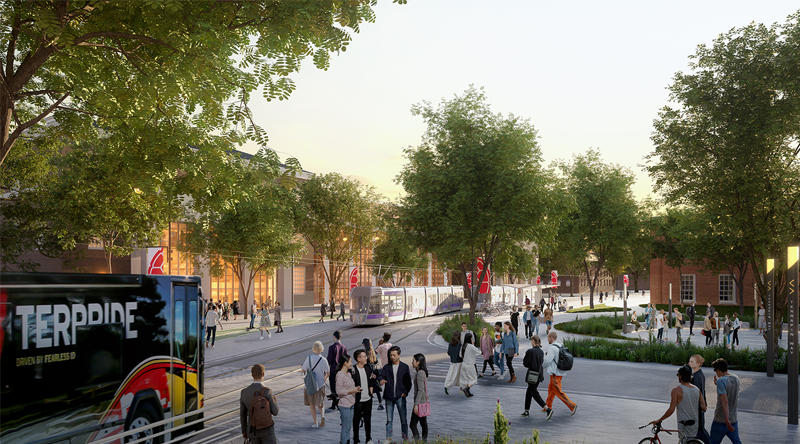By Eric Althoff
COLLEGE PARK, Md.—Architecture and design firm Cooper Robertson has revealed plans for a new campus expansion at the University of Maryland. The new facilities plan results from an 18-month community engagement process with students, staff and community stakeholders to help move the college campus into its next viable phase, which includes green spaces and more pedestrian thoroughfares.
Looking ahead at the next generation, Cooper Robertson’s planning includes identifying development capacity and upgrading those facilities that already exist on the campus. The college aims for net-zero carbon emissions by 2025, and improving multimodal transportation options given there will be five additional metro rail stations soon to debut near the campus itself.
“This plan builds on the University of Maryland’s role as an ambitious, forward-looking, and value-driven academic institution,” Cooper Robertson partner Mike Aziz said of the master plan for UMD. Aziz, himself a UMD alum, said that his alma mater is “setting a highly sustainable and lasting directive for the ultimate success of today’s and tomorrow’s students.”
Via the collaborations between the university and the various stakeholders, the school has come up with a wish list of projects to be tackled. This includes improving space and building performance for existing buildings as well as constructing new research facilities. The master plan also calls for a campus-wide “Innovation Walk” with open spaces and various renovated buildings, as well as biking and walking paths that connect areas both on and off the main campus. Furthermore, campus streets will be redesigned so that motor vehicles as well as scooters and bicycles connect key points on the campus while prioritizing pedestrian accessibility.
“Our Campus Facilities Plan is more than just a blueprint for development; it’s a commitment to our university’s holistic growth,” UMD President Darryll J. Pines said in an earlier statement. “This vision, fueled by input from our diverse community, signifies our dedication to creating environments where every student can thrive, learn and lead.”
In a subsequent statement emailed to School Construction News, Aziz of Cooper Robertson said that decarbonization is one of the key tenets of his firm’s plans for UMD as the school aims to move away from fossil fuels.
“Our strategy for achieving this centers on a phased shift from a centralized steam plant towards district-scale electrification,” Aziz said. “The idea is to combine satellite utility buildings with a large-scale geothermal system, alongside deep energy retrofits on existing buildings and a focus on very high levels of energy efficiency for new buildings. There are a lot of moving pieces in this strategy, but we think the environmental — and operational — benefits are well worth the effort.”
No general contractor has yet been announced for this master plan.
Cooper Robertson’s recent educational work includes expansions at George Washington and Georgia State, as well as other renovations at Caltech, Yale, Georgetown, Duke Medical School, Ohio State and the University of Delaware.


